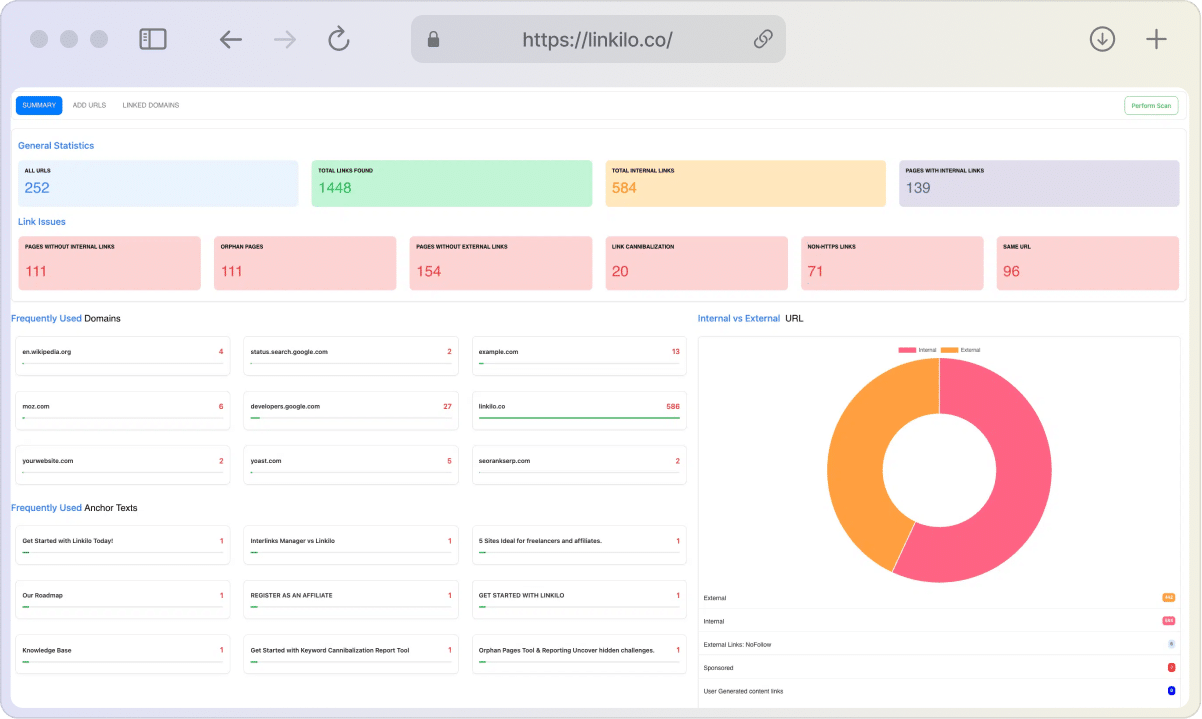Does SEO feel like an endless to-do list with no clear finish line? Are you spending hours on tasks that don’t seem to move the needle? Do you wish there was a way to simplify your SEO efforts and focus on what truly matters?
You’re in the right place. The 2024 Definitive SEO Checklist is your shortcut to higher rankings and increased organic traffic. We’ve cut through the noise and distilled the most essential SEO actions into a clear, actionable plan. Whether you’re a solopreneur, a small business owner, or part of a marketing team, this checklist will help you prioritize the right tasks at the right time.
No more overwhelm. No more wasted effort. Just a straightforward roadmap to SEO success.
- Overwhelmed by SEO tasks? This checklist prioritizes the essentials, so you can stop guessing and start acting.
- Need a solid SEO foundation? Get step-by-step guidance for keyword research, technical setup, and goal setting.
- Want to stay ahead of the curve? Learn how to adapt your strategy with regular reviews, competitor analysis, and fresh content
- Crave a streamlined SEO process? Discover the daily, weekly, monthly, and quarterly actions that drive results.
Recommendation: Stay agile and informed in your SEO approach, focusing on strategic planning, regular reviews, and consistent content optimization to effectively connect with your audience and achieve your business objectives.
SEO Tasks to Prioritize
As a marketer juggling numerous responsibilities, time is a precious commodity, particularly when vying for SEO prominence in competitive sectors. To optimize every moment, focusing on certain SEO tasks can accelerate your progress towards your objectives:
- Develop a Topic-Centric Approach: Align your efforts by formulating a strategy centered around relevant topics. This approach should guide all your content development activities.
- Ensure Website Indexability: Verify that your site is accessible to search engines for indexing. This is a foundational step to ensure your content has the potential to rank.
- Address Critical Crawler Issues Promptly: Regularly monitor and rectify any significant issues identified by crawler reports to maintain SEO health.
- Analyze Organic Rankings and Traffic Flow: Regular assessment of your site’s performance in organic search is crucial to understand your SEO status and make informed adjustments.
- Refine Existing Content: Continuously improve your current content to enhance its relevance and effectiveness in meeting user needs and search engine criteria.
- Generate New Content to Address Topic Gaps: Identify and fill in the gaps within your topic strategy with new content, ensuring a comprehensive coverage of your subject area.
Remember, the frequency and intensity of these tasks can be adjusted based on your specific goals and available resources.
Quick Glance of SEO Checklist
| Frequency | SEO Tasks | Key Points |
|---|---|---|
| One-Time | – Keyword Research and Strategy Formation | – Use tools like SEMrush or Moz – Focus on relevant keywords and topics |
| – Technical Setup and Tracking | – Install Google Analytics and Search Console – Submit XML Sitemap – Ensure website indexability | |
| – Content and Website Audit | – Plan topic-centric content strategy – Assess website for UX and accessibility | |
| Daily | – Monitor Keyword Rankings | – Track primary keyword performance |
| – Review Site Analytics | – Check for traffic anomalies and user behavior | |
| – Technical Issue Monitoring | – Scan for site downtime or loading problems | |
| – Content Ideation and Planning | – Brainstorm and plan new content | |
| Weekly | – Content Optimization | – Improve existing content based on performance |
| – Competitor Analysis | – Monitor competitors’ content updates and SEO strategies | |
| – Backlink Monitoring | – Track new and lost backlinks | |
| – User Engagement Analysis | – Assess engagement metrics like bounce rate and session duration | |
| Monthly | – SEO Strategy Review | – Adjust content and keyword strategies based on performance data |
| – Technical SEO Audit | – In-depth check for technical issues like broken links and crawl errors | |
| – Content Performance Review | – Analyze newly published content and update outdated content | |
| – Competitor Benchmarking | – Review competitors’ SEO activities and performance | |
| Quarterly | – Comprehensive SEO Strategy Review | – Evaluate overall SEO effectiveness and align with business goals |
| – Advanced Technical Audit | – Thorough technical examination for site improvements | |
| – Link Building Campaign Review | – Assess backlink strategy effectiveness and plan new initiatives | |
| – SEO Training and Knowledge Update | – Stay updated with latest SEO trends and algorithm updates | |
| – UX and Conversion Optimization | – Review and enhance website user experience and conversion paths | |
| – Stakeholder Reporting | – Present SEO performance report and align next quarter’s goals with stakeholders |
This table provides a clear overview of the SEO tasks, organized by frequency and detailing the key actions within each category. It serves as a comprehensive guide to manage and execute your SEO strategy effectively.
One-Time SEO Tasks

Establishing a solid foundation for your SEO strategy involves a set of crucial one-time tasks:
- Keyword Research and Strategy Formation: Start by identifying key phrases and topics relevant to your business using tools like SEMrush or Moz. Focus on keywords that resonate with your product, service, or customer pain points. Compile this data into a structured format, including search volume and competition levels. Tag crucial keywords that are most significant for your business for easier monitoring.
- Setting Realistic Keyword Goals: Instead of immediately targeting highly competitive keywords, begin with more achievable, long-tail keywords. This strategy allows you to build your domain authority and gradually progress towards more challenging keywords.
- Topic-Centric Content Planning: Embrace a topic-based approach for content creation. Organize your content around primary topics and related subtopics to comprehensively cover the subject. For instance, if your main topic is “home gardening,” a subtopic could be “best gardening tools for beginners.”
- Establishing Organic Traffic Objectives: Set realistic traffic goals, considering your content production capacity and market competition. Use these goals to guide your content creation and SEO efforts.
Technical Setup and Tracking
- Implementing Google Analytics and Search Console: Install these tools for in-depth tracking and analysis of your website’s organic traffic and search performance.
- Keyword Tracking Setup: Employ tools like Moz or SEMrush to keep an eye on your keyword rankings and monitor competitors’ movements.
- XML Sitemap Submission: Create and submit an XML sitemap to facilitate easier crawling of your site by search engines.
- Indexability Check: Confirm that your site’s content is being indexed by search engines. You can verify this through Google Search Console or by performing a simple site search on Google.
- SSL Certificate Installation: Enhance your website’s security and trustworthiness by installing an SSL certificate, shifting your site to HTTPS.
- Website Crawling: Use SEO audit tools to perform a thorough crawl of your website, identifying any metadata or structural issues.
- Fixing Major Crawler Errors: Prioritize fixing major crawl issues on key web pages, including your homepage, and plan a schedule to address other errors systematically.
- Meta Tag Optimization: Align your meta tags with your keyword and topic strategy, ensuring key pages have relevant titles, descriptions, and heading tags.
- Monitoring Site Speed and Uptime: Use page speed tools like Google PageSpeed Insights and Pingdom to keep track of your website’s performance and availability, which are crucial for SEO.
- Assessing Mobile Friendliness: Ensure your website is optimized for mobile devices, as this is a key factor in search engine rankings.
Quarterly SEO Task List

- Comprehensive SEO Strategy Review: Every quarter, take the time to review and adjust your overall SEO strategy. This includes evaluating the effectiveness of your topic strategy, keyword targeting, and user engagement initiatives in meeting your set OKRs.
- In-Depth Competitor Analysis: Conduct a thorough analysis of your competitors’ strategies and performances. Look for shifts in their SEO approaches, new content themes, changes in backlink strategies, and any new features or offerings they’ve introduced.
- Advanced Technical SEO Audit: Beyond weekly checks, perform a detailed technical audit to uncover deeper issues that might be impacting your SEO performance. This includes checking for site architecture improvements, enhancing mobile responsiveness, and ensuring compliance with the latest SEO best practices.
- Content Audit and Refresh Plan: Review all existing content for relevancy, performance, and alignment with current SEO standards. Plan to update, consolidate, or retire content that no longer meets your strategic goals.
- Link Building Campaign Review: Evaluate the effectiveness of your backlinking strategy. Identify successful tactics and areas for improvement, and plan for new link-building initiatives.
- SEO Training and Knowledge Update: Stay updated with the latest SEO trends and algorithm updates. Organize training sessions for your team to ensure everyone is on the same page regarding the latest SEO techniques and strategies.
- User Experience (UX) and Conversion Optimization: Assess the overall user experience and conversion paths on your website. Identify areas for improvement and implement changes to enhance user interaction and conversion rates.
- SEO Tools and Software Review: Evaluate the tools and software you are using for SEO. Consider whether new tools or upgrades are needed to improve efficiency or gain better insights.
- Set Next Quarter’s SEO OKRs: Based on your reviews and analyses, establish clear and measurable objectives and key results for the next quarter. Align these with your broader marketing and business goals.
- Stakeholder Reporting and Alignment: Prepare and present a comprehensive SEO performance report to stakeholders. Ensure that there’s alignment on goals, expectations, and resource allocation for the next quarter.
Monthly SEO Checklist

Regular monthly check-ins are vital for maintaining and enhancing your SEO strategy. Here’s a checklist to guide your monthly SEO activities:
- Refine Your Topic Strategy: Continuously revisit and update your topic strategy. This involves assessing the performance of your existing content, exploring new topic opportunities, and adapting to emerging trends and user queries.
- Evaluate Keyword and Featured Snippet Rankings: Monitor your keywords’ rankings each month. Pay special attention to significant shifts, especially for high-priority keywords. Also, keep an eye on featured snippet opportunities which can boost visibility.
- Analyze Organic Traffic Trends: Compare current organic traffic to previous periods (month-over-month and year-over-year). Identify pages that are gaining or losing traffic and investigate the reasons behind these trends.
- Assess User Engagement Metrics: Go beyond basic traffic data and dig into how users are interacting with your content. Metrics like session duration, bounce rate, and page views per visit can offer insights into content quality and user satisfaction.
- Conduct Competitor Benchmarking: Regularly review your competitors’ SEO activities. Look for changes in their content strategy, keyword targeting, and backlink profiles. This can reveal new opportunities or threats to your own strategy.
- Backlink Profile Analysis: Evaluate the quality and quantity of new backlinks to your website. Identify opportunities to gain more high-quality backlinks and monitor your competitors’ backlink strategies as well.
- Prioritize Upcoming SEO Tasks: Based on your monthly analysis, prioritize tasks for the coming month. This might include optimizing underperforming content, addressing technical SEO issues, or creating new content to fill gaps in your topic coverage.
- Content Performance Review: Analyze the performance of newly published content. Assess how well it’s ranking and engaging users, and determine if any immediate optimizations are needed.
- Page Experience and Core Web Vitals Assessment: Regularly review your website’s performance in terms of Google’s Core Web Vitals and overall page experience. This includes checking loading times, interactivity, and visual stability.
- SEO Experimentation and A/B Testing: Conduct A/B tests on various SEO elements like meta titles, descriptions, and different content formats to understand what works best for your audience and search engines.
- Review and Update Outdated Content: Identify and update any content that is outdated or no longer accurate. Keeping content fresh and relevant is important for maintaining rankings and providing value to users.
- Social Media and External Platform Performance Check: Assess how your content is performing on social media and other external platforms. This can provide insights into popular topics and content types, as well as potential areas for improvement in your SEO strategy.
- Technical SEO Audit: Conduct a regular technical audit to identify and fix issues like broken links, improper redirects, or crawl errors. Keeping your website technically sound is crucial for optimal search engine crawling and indexing.
- User Feedback and Query Analysis: Monitor user feedback, comments, and search queries to gain insights into what your audience is looking for and how well your content meets their needs.
Monthly and Quarterly Tasks Enhanced by Daily and Weekly Insights:
- SEO Strategy Review and Adjustment: The insights gathered from daily and weekly tasks contribute to the broader monthly and quarterly SEO strategy reviews. These reviews should incorporate findings from ongoing monitoring to ensure the strategy remains relevant and effective.
- Technical SEO Audits: Daily and weekly detections of technical issues should be addressed immediately, but a more thorough analysis during monthly or quarterly audits can help identify systemic problems and opportunities for technical improvements.
Weekly SEO Tasks

- Content Optimization: Dedicate time each week to improve existing content. This includes updating information, enhancing readability, and ensuring SEO best practices are followed.
- Analyze User Engagement Metrics: Weekly, dive into metrics like page views, session duration, and bounce rates to understand how users interact with your site and identify content that needs refinement.
- Backlink Analysis: Regularly check for new backlinks to your site, assessing their quality and relevance. Also, keep an eye on lost backlinks to understand their impact.
- Competitor Analysis: Weekly monitoring of your competitors’ activities, such as content updates and ranking changes, helps you stay competitive and spot opportunities.
- SEO Experimentation: Conduct regular A/B tests on various elements like meta tags, headings, and calls to action to refine your SEO approach based on what resonates with your audience.
- Content Creation and Publication: Establish a weekly schedule for producing and publishing new content to ensure a consistent flow and to keep your website fresh and engaging.
- Technical SEO Audit: Conduct a thorough check for technical issues, such as crawl errors, broken links, or site speed issues, and address them promptly.
- Content Brainstorming and Collaboration: Organize weekly brainstorming sessions with your team to generate new content ideas and discuss SEO strategies. Collaboration can lead to more innovative approaches and ensures alignment with broader marketing goals.
- SERP Feature Monitoring: Regularly check search engine results pages (SERPs) for changes in layout or new features that could impact your SEO strategy, like new types of featured snippets or changes in local pack listings.
- Internal Link Auditing: Review and update internal linking strategies to ensure optimal link distribution and navigation throughout your site, which can enhance both user experience and SEO.
- Email Campaign Performance Review: For businesses heavily reliant on email marketing, reviewing the performance of email campaigns in driving website traffic can be a valuable weekly task.
- Collaborate with Other Departments: Engage with sales, customer service, and product development teams to align SEO efforts with overall business objectives and to gain insights that can inform content creation.
Weekly Tasks Influenced by Daily Observations:
- Content Optimization: Daily insights into content performance can guide weekly optimization efforts, ensuring that the content is continuously refined and updated.
- Competitor Analysis: Observations made during daily competitor monitoring can be compiled and analyzed more comprehensively on a weekly basis to understand competitor strategies and adjust your own accordingly.
Daily SEO Tasks

- Monitor Keyword Rankings: Daily tracking of your primary keyword rankings can alert you to sudden changes that may indicate algorithm updates or shifts in competitor strategies.
- Review Site Analytics for Anomalies: Check your website analytics daily for any unusual activity, such as spikes or drops in traffic, which could indicate technical issues or emerging content opportunities.
- Engage with Your Audience: Respond to comments, queries, and feedback on your website and social media platforms. This engagement not only improves user experience but can also provide insights into content refinement.
- Check for Technical Issues: Perform a quick scan for issues like site downtime or loading problems, as these can significantly impact user experience and SEO performance.
- Content Ideation and Planning: Allocate time each day to brainstorm and plan new content. This keeps your content pipeline full and ensures a steady flow of fresh material.
- News and Industry Updates: Stay informed about the latest trends and updates in SEO and digital marketing. This could include reading industry blogs, news sites, or attending webinars to stay ahead of the curve.
- Social Listening: Monitor social media and other platforms for brand mentions, industry trends, and competitor activities. This helps in understanding market sentiment and identifying content opportunities.
- Performance Metrics Review: Check key performance indicators (KPIs) daily to quickly identify and respond to any drastic changes in website traffic or user behavior.
Daily Tasks Revisited:
- Keyword Rankings Monitoring: While done daily, significant changes observed should be analyzed more deeply in weekly or monthly reviews to identify trends and inform strategy adjustments.
- Site Analytics and Anomalies: Daily anomalies should prompt a weekly in-depth analysis to understand their impact and potential long-term implications.
- Technical Issues Monitoring: Immediate technical issues identified daily should be addressed promptly; however, a more thorough technical audit should be conducted on a monthly or quarterly basis to identify underlying patterns or systemic issues.
- Content Ideation and Planning: Daily brainstorming feeds into the weekly content creation schedule. It also helps in shaping the monthly and quarterly content strategy, ensuring alignment with broader marketing goals.
Keyword Research and Strategy Formation
Technical Setup and Tracking
Content and Website Audit
Monitor Keyword Rankings
Review Site Analytics
Technical Issue Monitoring
Content Ideation and Planning
Content Optimization
Competitor Analysis
Backlink Monitoring
User Engagement Analysis
SEO Strategy Review
Technical SEO Audit
Content Performance Review
Competitor Benchmarking
Comprehensive SEO Strategy Review
Advanced Technical Audit
Link Building Campaign Review
SEO Training and Knowledge Update
UX and Conversion Optimization
Stakeholder Reporting
FAQs
What are the absolute must-do SEO tasks for beginners?
Beginners should prioritize establishing a solid foundation. This includes:
- Thorough keyword research and strategy development.
- Technical website optimization (ensuring indexability, fixing crawl errors).
- Creating high-quality, optimized content that aligns with their target keywords and topics.
How often should I update my SEO strategy?
The frequency of strategy updates depends on several factors, including your industry's competitiveness, your website's size, and the rate of content production. However, it's generally recommended to review your strategy comprehensively every quarter and make minor adjustments monthly or weekly based on data analysis.
Is it necessary to hire an SEO professional, or can I handle it myself?
While it's possible to manage SEO yourself, especially with resources like this checklist, hiring an SEO professional can be beneficial if you have a complex website, lack time, or want expert guidance for more advanced strategies.
Is this SEO checklist suitable for all types of websites and businesses?
Yes, this checklist provides a comprehensive framework for SEO, applicable to various website types and industries. However, you may need to adjust the frequency and depth of certain tasks based on your specific niche and goals.
How do I prioritize tasks in the SEO checklist if I have limited time or resources?
Start with the one-time foundational tasks like keyword research and technical setup. Then, focus on high-impact tasks like content optimization, competitor analysis, and technical audits. You can adjust the frequency of other tasks based on your capacity.
What are the best tools for performing the SEO tasks listed in the checklist?
Several excellent SEO tools can help you with different tasks:
- Keyword research: SEMrush, Ahrefs, Moz
- Technical audits: Screaming Frog, DeepCrawl
- Rank tracking: Moz, Ahrefs, SEMrush
- Analytics: Google Analytics, Google Search Console
- Content optimization: Clearscope, MarketMuse
Should I focus on on-page SEO or off-page SEO first?
Both on-page and off-page SEO are crucial for success. However, it's often recommended to start with on-page optimization to ensure your website is technically sound and your content is optimized for your target keywords before focusing on building backlinks (off-page SEO).
How often should I be creating new content for my website?
The ideal frequency of content creation depends on your industry, resources, and goals. However, consistency is key. Aim to publish new content regularly, whether it's weekly, bi-weekly, or monthly.
What should I do if I see a sudden drop in my website's traffic or rankings?
Don't panic! First, investigate the cause of the drop. Check for any recent algorithm updates, technical issues, or changes in competitor strategies. Use your SEO tools to analyze your data and identify any potential problems. Once you understand the cause, take corrective action, such as fixing technical errors or adjusting your content strategy.
Can I use this SEO checklist to create my own custom checklist for my business?
Absolutely! This checklist serves as a comprehensive guide, but you can adapt and tailor it to your specific business needs, resources, and goals.
Conclusion: A Strategic, Agile Approach to SEO
Effective SEO requires ongoing vigilance and adaptability. Success lies in being informed, flexible, and continually seeking enhancements.
Your SEO strategy should balance technical proficiency, content quality, and user experience. This means regularly assessing and adjusting your methods in response to new data and market shifts.
Ultimately, SEO is about effectively connecting with your audience. Keep your strategy user-centric to build a meaningful online presence that resonates with your audience and supports your business objectives.




